#and to be clear this is not a slight against cgi folks
Text
.
#seeing bts of the loki finale and damn its one big blue screen#remember when marvel used to build all the asgardian sets#and now there’s nothing#no artistry no craft#just cgi#who are all underpaid overworked and not union#hate it here#and to be clear this is not a slight against cgi folks#they do amazing work#but it’s all about soending as little money as possible now#god forbid we spend money on physical craftsmanship
20 notes
·
View notes
Text
A View from Behind the Camera - GoT episode 6 x 9 - Battle of the Bastards part 2
It’s time for us to explore another section of the Battle of the Bastards. In my last post we looked at the top of the scene to Ramsey’s line “Do you like games, little man?” We will start from there and end on the section of Rickon’s death. I happen to have a copy of the script as well and I will be following along with it as we go. I will be pointing out things in the script and how they do or do not show up on the screen and how the sentiments changes once in the hands of Miguel Sapochnik. So without further ado away we go! (It’s a long one. Sorry, folks)
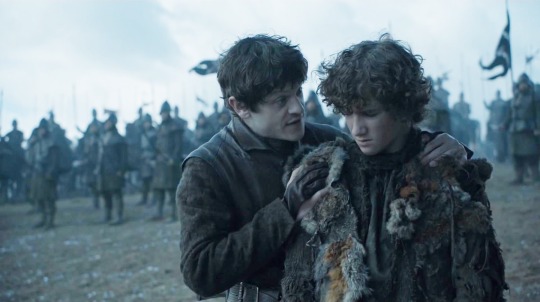
We’re starting off this section with a two shot of Ramsey and Rickon. Rickon is blocked in front of Ramsey. Ramsey has his hands on Rickon’s shoulders and he is leaning in to say his next. We cut to a two shot before a reverse one so we are looking down the field at Jon and the Winterfell fight crew (Yeah, that’s what I’m going to call them) while we aren’t technically in Ramsey or Rickon’s POV that is what this shot is. We are in over the shoulder. Then we cut back to the two shot of facing Rickon and Ramsey and we hold here until Ramsey’s line “The sooner you make it to him, the sooner you get to see him again.” It’s important to note that the music that was previous underscoring the scene has gone silent. We have the dialogue and the sound of breathing (which would have been added in post). After the line we do a quick cut to Jon in close up. It’s not an extreme close up but it is pretty close. He is not centered in the shot which is done purposefully. Every shot that Sapochnik uses in the scene is slightly off kilter. This is to really drive home the uncomfortable nature of the situation. We cut back to Ramsey and Rickon in a close up of the same distance as Jon’s previous. Then we cut to the over the shoulder shot of Ramsey and Rickon as Ramsey sends Rickon down the field.
What I love about the next series of shots is how they build the tension for the viewer. We don’t know what it coming from Ramsey, we know he is up to something and we are all aware enough to know that Rickon is going to be wormfood, We just don’t know how that happens yet. The stage directions in the script at this point are very sparse so this is all Sapochnik painting us a picture. We cut to a shot of Ramsey. We are at an extreme angle and we are shot from below.

This makes Iwan almost larger than life against a grey background. The script gives us the stage direction of “Rickon turns. He sees the approaching solider, and what he’s carrying: a mean looking longbow and a quiver of arrows.” But that’s not what Sapochnik gives us. He’s still building the tension here so he ignores this set of directions in order to keep that slow burn going. We cut to Rickon’s face, he is visibly scared - the viewer knows there is something over Ramsey’s shoulder just out of frame but we are still kept in the dark about it until we cut back to Ramsey, using the same off kilter extreme angle shot as before but this time the soldier with the bow enters the scene.
We cut to a wider shot of Rickon starting to run and then a close up of Jon. Jon’s close up is almost split second before we head back to Ramsey. This time we have a two shot of Ramsey and the soldier. Ramsey pulls an arrow. He pauses and stares down the field at Jon. It’s a great directorial choice. We cut once more back to Jon. He turns and runs to his horse, the camera staying steady where it was for the close up. We shift to a closer camera angle as Jon jumps on his horse.

Once Jon charges forth we see that Tormund is behind him. The camera zooms in to focus on Tormund as he moves forward while Jon rides out of the shot. Next we have a close up of Davos on horseback, he is clearly watching Jon ride down the battlefield (And thus ignoring every single strategic bit of advice he was given in the tent scene earlier on.)
We cut to a long shot of Jon riding down the battlefield. This was most likely shot with a Russian Arm attached to the Land Rover I know they used for this sequence. It allows for a great range of motion and they can match the speed of a horse with it. Jon rides through the shot. What that means is the camera is stationary and Kit rides from one side of the frame to the other.
Next we cut back to Iwan as he nocks his arrow. Iwan has been directed to take his time nocking the arrow, to really enjoy it. It is clear that the direction Iwan was given is that you’ve scored ahead in the game. He got Jon to do what everyone told him not to do. Ramsey has the advantage. Extreme close up on Ramsey’s hand as he nocks the arrow which cuts to a shot of Rickon running down the field. The shot starts at his feet and quickly pans up his body so we can see him look over his shoulder at Ramsey.

Now we have an aerial shot of Rickon running down the field in between the columns of burning bodies on St. Andrew’s Crosses. This is a practical shot and not CGI. The field they are shooting in is honestly this big. Sapochnik gives us this view for two reasons 1. to show the grand scale of the battlefield and 2. to show the viewer that no matter what Rickon is not getting out of this alive. That said, he still ups the ante with the next series of shots.
We quickly cut to Ramsey as he shoots the first arrow. Then to a shot of Rickon’s feet as he runs hard, that pans up his body until we get to his shoulders. Also we need to note that once again we are giving an off kilter angle for this shot.
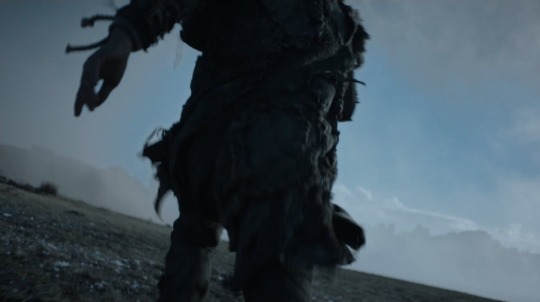
Once the pan reaches his shoulders we cut to a close up of his face. He is scared as hell, panting, and looking over his shoulder. Cut to a wide shot from field angle so we can see the arrow land near Rickon but not close enough to be a danger. We cut to a frontal shot of Rickon running, where he also trips over his feet. My bet is that was by accident but because he looks organic they kept it in the shot. We cut back to Ramsey and his quiver-bearer. The script tells us “Ramsey nocks another arrow, taking his time. He draws. He fires.” What we get is so much more. First Iwan has been directed to shrug and sigh at the missed first shot. Then he nonchalantly turns and pulls another arrow free. We get a close up of his face at the end of the follow through. Another great facial expression by Iwan.
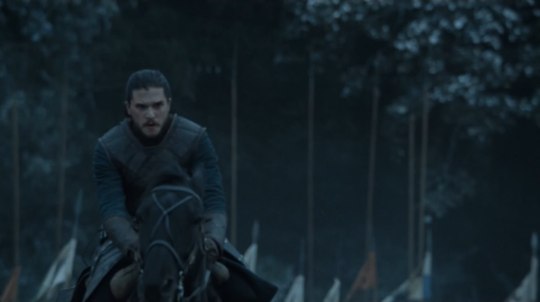
We cut to Kit as he thunders down the battlefield. The camera does a slight slow pan with him as he goes. It is clear from his facial expressions and how he is riding that Jon is digging his heels in to get to Rickon. We flip POV and watch from the frontline as Jon continues across the field. We get a wide shot of the distance again, we can see a speck of Rickon as he runs from the other side between the columns of flayed men. Back to a favor on of Ramsey, this time in profile with the arrow nocked and ready to fly. Iwan has been directed to turn his head so that he is not focused on Rickon when he shoots. We cut to a favor on in the frontal position and the he lets the arrow fly, turns his focus back to Jon and Rickon and lowers the bow with a smile. Ramsey is toying with both of them. Also it is important to note that SmallJon Umber and Karstak both had lines and reactions script wise in this section. Sapochink’s choice to leave them on the cutting room floor was the correct one in my opinion. Despite the sheer size of this battle it is an intimate story between two bastards. Jon and Ramsey. How they are foils for one another.
Cut to an over the shoulder shot of Rickon running from Ramsey POV and then to a close up of Rickon from an upward angle. Next we get another aerial shot, this time from a different POV of the field. We see how close Rickon is to Jon.
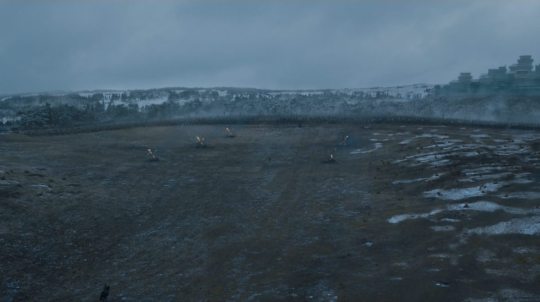
Jon actually rides into the frame. Next we have a close up of Jon as he rides, determined, again he is not centered in the shot giving that same off kilter view to the audience. Also it’s important to note that the music has started to build in a minor key and is a steady, droning melody.
Now we cut to an extreme closeup of Ramsey pulling another arrow from the quiver. This makes the viewer believe this will be the arrow that kills Rickon.

Cut to a running Rickon, again from the below upward angle. Followed by a shot of Jon riding hard now. He’s been directed to twist in the saddle and reach his arm out and down to scoop up Rickon when (if) he reaches him.
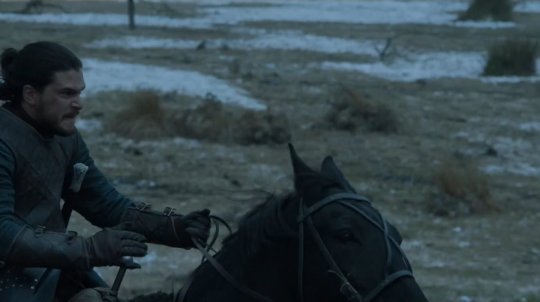
We get a long shot of Kit riding, hand out stretched then a cut to a close up of Rasmey as he prepares to shoot. Pan to an extreme close up of the arrow point to a close up of Rickon running, the sun shining behind his head. Back to close up of Jon to extreme close up of Ramsey in profile to extreme close up the arrow point as he looses to close up of Ramsey in profile again to Rickon and finally to the arrow landing in the ground close to Rickon.
The shots in the sequence come faster and faster as Sapochnik builds the tension to it’s pinnacle. When we see the arrow land on the ground the audience is lured into a false sense that Rickon will make it. That Jon will scoop him up and ride him back to safety at the frontline. The music stops with the sound of the arrow breaking as Rickon runs it over.
We get a POV shot from Jon’s knee of his horse’s head as the ride toward Rickon then a wide shot view shot of the battlefield were we see the Stark Boys getting closer still.
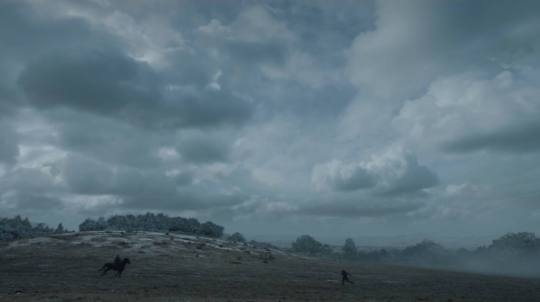
Cut to Rickon and then wham, arrow through the heart. This is the insidious genius of Sapochnik. He has lured the viewer into a false sense of rightness. We inherently believe in the power of things coming in threes so a fourth arrow is out of the normal pattern. Also this is the only time we don’t see Ramsey shoot. It comes out of nowhere. Rickon turns and falls to the ground. We get a close up of his face as he gasps for breath. Cut to Jon, who is out of focus and is in slow mo, we can also hear a slowing heartbeat as Jon is brought into focus. Extreme close up to a very pleased Ramsey. Cut to Jon from Rickon’s POV.

We hold with Jon a few beats and then down to Rickon on the ground. This is one of my favorite parts of this section. As the breath fades out of Rickon so the light fades in the shot. It’s a subtle and perfect touch. (Thank you @thelawyerthatwaspromised for making this gif for us) The entire feel of the scene shifts once again in that moment.
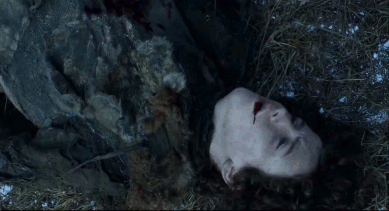
And on that note...we’ve come to an end. Next up we will cover likely up to when the Knights of the Vale arrive. As always my asks are open for questions. Also if you would like me to analyze other scenes please feel free to ask and I will slot them in.
See ya next time!
#Jon x Sansa#jonsa is here#jonsa#battle of the bastards#directorial analysis#Female directors#jonsa is coming#jonsa is endgame
110 notes
·
View notes
Photo

2021 Mitsubishi Pajero Sport Exceed Reviewed
The hulking seven-seater Mitsubishi Pajero Sport can be a little rough and ready in its execution, but there’s an undeniable charm there.
I see it immediately: the stricken look on the face of the tradie who’s just parked me in.
You see, he’s just realising now that the owner of the hulking, bullbar-wearing 2021 Mitsubishi Pajero Sport he’s parked dangerously close to isn’t, in fact, a fellow tradie, but a pregnant woman with a broken foot.
It’s too late, though – he can’t very well admit he profiled me based on my car, and can only compensate me with a sheepish smile and the good grace to avert his eyes as I desperately try to get my very big car out of a very small space.
At its core, the seven-seater Pajero Sport is an affordable family car, but it feels like it might be better suited to the kinds of families that regularly tow a boat, own a full wardrobe of Driza-Bones or holiday on a cattle farm.
That’s probably because this makes no secret of being the SUV version of the Triton ute, with utilitarian styling, a comfortable but basic cabin, and serious ride height and heavy handling. Plus, the car I’m testing here is fitted with an imposing black bullbar.
The Exceed variant on test starts at R 704,995 (including admin costs), and offers diesel power by way of its 2.4-litre, four-cylinder turbo-diesel engine and eight-speed automatic transmission.
The four-wheel-drive system allows you to switch between drive modes for optimal traction – from rear-wheel drive to on-road high-range four-wheel drive, to four-wheel drive with a locked centre differential in high-range and low-range for heavy-going.
There’s also a drive-mode selector with the option of gravel, mud, snow, sand or rock.
South Africa is reasonably well served for big, booming, body-on-frame, diesel off-roaders, including the Mitsubishi Pajero.
As far as top-spec offerings in this class go, the Mitsubishi is relatively affordable, particularly when compared with the Ford and the Toyota.
However, the other brands are worth checking out in tandem with Mitsubishi, as you might find they provide a bit more standard equipment and a more premium feel in the cabin for your spending.
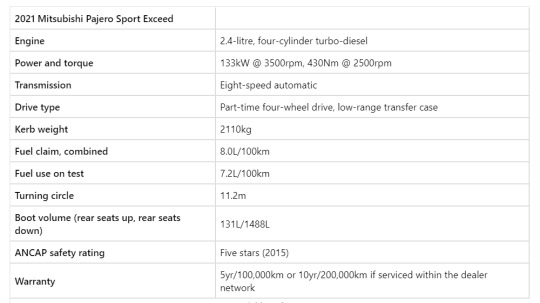
Getting into the car is an exercise in athleticism, with some vaulting required to get oneself up and into the driver’s seat, greatly aided by the grab handles littered around the car’s interior. Conversely, getting out is easier, and you’ll find yourself sliding or jumping out of the driver’s seat in a cavalier fashion in no time.
Once you’re up on the proverbial throne, it feels like you’ve entered another zone entirely. You’re able to make eye contact with dual-cab ute owners and small-truck drivers, and even offer them a knowing wave.
The rear windshield is nice and tall, so you get a greater depth of view at the back, while the side mirrors are huge, meaning side visibility is excellent, too.
However, I relied heavily on the 360-degree camera that’s exclusive to the Exceed grade – and can admit that at times I would have been lost without it, particularly when parking. The view provided to the driver is a composite of a CGI-generated image of the car, paired with real-time footage from cameras placed around the vehicle.
The height of the car – it has 218mm of ground clearance – also means you don’t have to worry about kerbs or raised sections of road.
In the driver’s seat, the car has a comfortable, utilitarian vibe, with the Exceed offering a solid amount of equipment and technology, and a few measured attempts at offering a 'premium' feel.
You’d never accuse it of being luxurious, but the heated leather seats are smooth and practical with understated stitching, and the dash is accented with black gloss plastic and silver trim that keeps things looking polished.
A sizeable centre console houses two cupholders and three USB ports – two compatible with smartphones.
Hit the push-button start and there’s no mistaking this is a diesel car – the grumbling, rumbling feel in the cabin and the dull roaring noise is immediate when you’re idling, but it does tend to level out as the car gets moving.
Straight out of the gate, you’re likely to notice the steering – for me personally, it was arguably the most noteworthy feeling during my time in the Pajero Sport, and something that takes some serious getting used to.
In short: it’s notably heavy and takes brawn to manage, especially in smaller streets. However, I’m more accustomed to medium SUVs and hatchbacks with a light steering feel, so the Pajero Sport definitely felt very ute-y to me (and dual-cab owners might feel right at home).
Swinging out of parallel parks, I found I had to muster as much of my meagre upper body strength as possible to haul the big Mitsi into line.
The eight-speed transmission does a nice job of effectively shifting through gears without any hesitation or fidgeting. Meanwhile, the engine offers up 133kW of power and 430Nm of torque, and while it handles low-speed traffic well, it can feel somewhat lethargic with moderate to high throttle input.
Still, there’s ample capacity there, it performs well under pressure and it never feels underpowered – it’s just lacking that punchy, peppy feeling in the middle to upper range of acceleration. That’s not necessarily a mark against the car, however, given you’re unlikely to feel much like putting your foot down or speeding around bends.
Much of this is to do with the ride height and suspension feel, which can equate to a top-heavy, wobbly sensation when taking corners or driving over larger bumps at speeds of over 50km/h.
Otherwise, it remains a composed and comfortable car, and I feel a little bit like the princess in The Princess and the Pea by complaining about any discomfort, given you’re so far removed from the road it’s tricky to ascertain any irregularities at lower speeds.
While I didn’t venture off-road for long, dirt roads and some hilly, unpaved areas in the bush were no issue for the Pajero Sport – especially in 4H mode, which allows the car to operate in full-time four-wheel drive.
I was particularly impressed with the fuel consumption of the Pajero Sport. Around town, it sat bang on the quoted 8.0L/100km on a combined cycle, and with more freeway driving in the mix that quickly dropped to a low 7.2L/100km, which I felt was very respectable for a car of its size.
That’s a win because good fuel consumption is likely a major reason to buy a diesel car. The other key reason you’re looking at this car is cabin space, and on that front, the Pajero Sport has positives and negatives.
The middle row is well equipped with a 150W socket, two USB ports, roof-mounted air vents and an armrest with cupholders.
It’s nice and roomy in there for two people, with plenty of knee room even for lofty folks – although taller people (six-foot and above) might find their head hits the roof because the bench sits quite high in the car. Unfortunately, the middle seat in the second row is a bit narrow, so sitting three across as adults might compromise elbow room.
There are only three spots for child seats in the Pajero Sport, with ISOFIX anchorage points on each of the outboard seats in the second row, and three top-tether restraints over the back of the middle row. That means the third row can only be used for children who don't require car seats.
Obviously, the Pajero Sport is a three-row car, but getting all three rows into place with enough room for all occupants can be a bit of a logistical struggle. I found that everything didn’t fit that neatly together. Having the third row flat with the second row in action requires you to shift the middle row forward in order for things to feel well spaced.
Once again, as a woman lacking in upper body strength, I would have appreciated some electronic levers to adjust the rear rows, given the manual tabs and pulls in both the middle row and the rear row can take a bit of gusto to use (not to mention a bit of back-and-forth action to get everything where you want it).
Getting into the third row is easiest when you fold the middle-row seats forward and in half to create a clear path of entry. Once you’re in there, third-row legroom and headroom aren’t all that bad, and the sizeable windows prevent it from feeling dark and cramped.
If you want maximum cargo capacity, it is possible to fold the back two rows to create a positively cavernous compartment, but the floor isn’t entirely flat, with a slight downhill slant.
The Pajero Sport offers a full-size spare wheel under the floor and a solid – if not overachieving – list of standard equipment.
There’s active cruise with distance control, lane-change assist (which sounds an alarm if you’re veering into another vehicle but errs on the subtle side), front-seat heaters, the aforementioned overhead camera with rear sensors, and an 8.0-inch infotainment screen with Apple CarPlay and Android Auto.
A small complaint – the car never remembered my phone when pairing with Apple CarPlay, ignoring my ‘always enable’ prompts and asking for authentication every time I plugged it in (I had the same issue with my last Mitsubishi, too).
It’s missing any form of active lane-keeping or lane-tracing to keep you centred, and there’s no head-up display, but a large digital speedometer in the centre of the driver display is large enough to compensate.
There’s also autonomous emergency braking but, fair warning, I found it quite terrifying – sounding a loud alarm and slamming the brakes on in traffic when I came a little close to a car in front at a low speed.
Mitsubishi's 10-year, 200,000km warranty is a drawcard for anyone happy to service exclusively within the Mitsubishi dealer network, but those who want to use their own mechanic will receive five years or 100,000km.
Despite initially taking issue with some of the Pajero’s less refined qualities – the steering, the fiddly rear rows, that trademark diesel grumble – I came away surprisingly charmed by this car.
It’ll have you feeling like you can tackle a rocky mountain outcrop at a moment’s notice, squeeze in a mountain of rubbish, furniture or gardening goods without fretting about space or mess, take your family (and pets) away for a weekend in the country, or simply amble around town without blowing your budget on fuel or contending with kerbs and potholes.
And even if you don’t require that bullbar around town, it adds a certain aesthetic edge (and some strong tradie energy).
Article sourced from https://www.caradvice.com.au/
0 notes